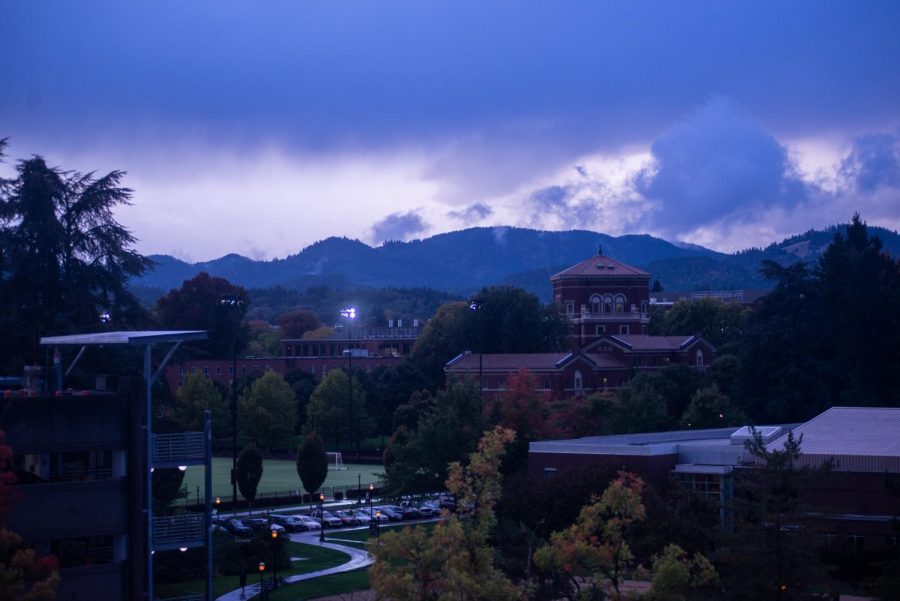Castles: Daylight saving time is outdated
A view of the sunset on Oct. 10 framed by Finley Hall, Weatherford, the intramural fields and mountains. On Nov. 7, clocks will go back one hour for daylight saving time.
November 1, 2021
Editor’s Note: This column does not represent the opinion of The Daily Barometer. This column reflects the personal opinions of the writer.
You may be looking forward to Nov. 7 for the biannual change of the clocks back to standard time, but the extra hour of sleep may actually do more harm than good.
Daylight saving time, referring to the act of setting clocks forward one hour from standard time, is the cause of these clock changes, but the tradition is long outdated.
“Daylight saving [time] is rather silly,” said Olivia Worley, a third-year biochemistry student at Oregon State University. “In this modern day and age, the amount of daylight we have is virtually inconsequential.”
Worley is not alone in her sentiments against daylight saving time.
“It seems pretty archaic,” said Morgan Thiers, an OSU third-year mechanical engineering student.
So why is daylight saving time still a thing? To begin to answer this, we can look at how it began in the first place.
According to timeanddate.com, while there was interest in seasonally changing the clocks prior to the twentieth century, the first countries to institute daylight saving time were Austria and Germany in 1916 to save fuel during the war.
After that, the practice spread to over 70 countries including the United States, where in 1966 the Uniform Time Act standardized daylight saving time to begin the second Sunday of March and end the first Sunday of November.
In the days of oil lamplight, daylight saving time made sense. Shifting one hour so that the daylight extended further into the evening in the spring and summer months meant less fuel would be needed to keep things lit.
“I don’t think continuing to move the clocks twice a year makes sense or is sustainable,” Thiers said.
His sentiment is not far from the truth. With today’s technology, the theorized benefits are actually slim to none. According to a 2008 U.S. Department of Energy report, the energy savings from switching between daylight saving time and standard time were negligible.
Daylight saving time, therefore, no longer serves us any purpose.
It is no surprise, in that case, that there have been many efforts to abolish this time change, including in Oregon.
In 2019, the Oregon State Legislature passed Senate Bill 320, which was then signed into law and would abolish the changing of clocks. However, rather than switch back to standard time, SB 320 would keep most of the state—apart from the area that is in mountain time—on daylight saving time.
So why are Oregonians still changing clocks this fall?
The short answer is because California has not also adopted the same law. SB 320 has a provision that states it will take effect the first November that both Washington and California sign the same bill into law.
While Washington passed a bill the same year as Oregon, California lawmakers failed to pass a bill in both 2019 and 2020. If California doesn’t pass the bill, the Oregon law is only valid until 2029.
While there is momentum to drop the clock change, not everybody wants that.
“I don’t think it matters one way or the other if we keep daylight saving [time] or get rid of it,” said third-year sociology student Jessica Findlay.
Perhaps she is right. Some people also argue that extended daylight hours in the evening encourage people to go outside and that it supposedly helps the tourism industry by having more time for people to go out on the town.
These reasons are only superficially justifiable when one considers that nightlife is an attraction and even with daylight saving time, it still is cold and dark in the evenings.
Furthermore, daylight saving time may actually cause more harm.
According to the National Bureau of Economic Research, when daylight saving time was introduced to Indiana in 2006, it actually increased energy consumption between 1% to 4% through the seasons, which we should be avoiding in the age of climate change. As a result, social costs from increased pollution ranged from $1.7 to $5.5 million per year.
The negative effects do not stop there either. Timeanddate.com reports many health issues that the changing of the clocks contributes to, including increased heart attacks in the spring, car accidents, miscarriages and more.
“If daylight saving [time] isn’t accomplishing the job that it was created to do, maybe we should just get rid of it,” Findlay said.
“Get rid of it” we should. With all these downsides to daylight saving time, there is little reason to continue changing our clocks twice a year.
Arguments for daylight saving time rely on the assumption that abolition means staying on standard time, which on the West Coast, it does not. Staying on daylight saving time would keep sunsets later in the evening year round.
“It would save everyone an unnecessary hassle that seemingly no one wants,” Worley said.
Ridding ourselves of daylight saving time would do more than save ourselves a hassle, though. Doing away with the clock change could potentially save lives.











































































































